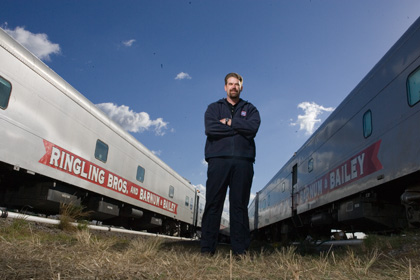After reading the bio. of Alex Kettles,
above, I had a few questions for Alex as we met in the Pie Car at 10:30
a.m. on July 20, 2006 in Los Angeles.
Alex has worked for Ringling Bros. and Barnum and Bailey as the
Trainmaster of the Blue Unit for about a year. He was an
Conductor for CSX out of Cincinnati for six years. He found out
about the job by searching the Internet. He interviewed for this
job Sept. 28, 2005. He spent a month training on the Red Unit
before taking over the Blue Unit.
Alex says his job description is not the traditional Trainmaster job
description. He mentioned that this is a unique train that
carries animals, people and freight. He has additional
responsibilities that a traditional Trainmaster does not have, such as
air conditioning in the residential coaches, water and electrical
systems. He compliments his staff for their many abilities beyond
their job descriptions, such as welder and handyman who can also change
wheels on a train car!
He works with dispatchers on the various roads and uses the railroad
atlas to find ways to get from venue to venue. Dealing with
locomotive crews who might arrive to take the train to the next city
and say they are not qualified to pull such a train, need some
on-the-job training. They soon realize that Alex has the
knowledge and experience and they cease complaining and get the job
done. Many crews want to back the train to get it through a wye,
but the Circus train cannot be backed, except in special circumstances.
Alex needs to call for power soon after arrival in the city previous to
the one where he needs power. He is also helped by the railroad
managers at the home office and the train has been to these cities many
times so routines are already established.
He must be prepared to make on-the-spot decisions. He related one
instance when, after the train was spotted, the switch was spiked,
unbenounced to them. This was discovered when they were loaded
and ready to pull out for the next city.
Getting the train buttoned up for travel is unlike any other
train. Bicycles and dishes have to be brought in.
Three-hundred people have to be accounted for and those who drive need
to get off from their compartment and get to their car. He
compliments Porter T. Graham for her help with personnel issues as to
who should be on and who should be off the train when they move.
Even though the Red Unit (32 coaches) may have been in a town last
year, the Blue Unit is longer (35 coaches) and may have new issues when
spotting the cars.
The Blue Unit has 4 stocks (animal cars), 35 coaches, 2 concession
cars, and 18 flatcars, 2 with ramps, for a total of 59 cars!
The locomotives lead the train, followed by the animal cars, the most
stable area on the train. I asked why this was the most stable
and Alex explained that the stocks and coaches have no slack and they
have to be in front. The concession cars and flat cars are
converted auto carriers, and have slack, so they must be at the
end. There are rare exceptions to the 'no-backing' rule.
Some instances, when the power can be run around at the spotting point,
and when the next venue is 30 miles or less, and the train is not run
over 30 mph, then the train can be backed.
The four animal cars have 3 attendants who ride in these cars when they
move, including a Cossack who rides with their horses. In my
earlier report I mentioned how the animal cars are equipped with
misters and that the animals are exercised on long moves. Alex
mentioned that when they crossed hot states, the water for the animals
was getting warm so they added foam insulation to the onboard water
tanks.
The heavier cars have 6 axels (see my pictures) and ligher ones are
four-axel. The refurbishing shops are in Palmetto, Florida.
Security is handled by the Railroad Police, security assessments are
done regularly, and the train staff all have radios and cell
phones. Experience has shown in which cities they need to hire
additional local security officers.
Medical needs are served by onboard personnel or they are taken to a
local hospital (noted on each cities log pages) by company vehicle or
taxi. Of course, 911 is called for majoy medical issues.
Operating a "Town Without A ZIP Code" is a big job, especially when the
'town' has between 250 and 300 residents plus animals!
Not all circus personnel stay on the train, some own trailers which you
might notice when you go to the circus.
Don't miss the Animal Walk, from
the Ringling Brothers,
Barnum & Bailey Circus
train to the arena, when the Circus comes to your town. The
animal walk in Anaheim is tentatively scheduled for 2 pm Monday, July
24, 2006, near the corner of Douglass and Cerritos Streets, north of
the Anaheim Pond. Take the kids and enjoy!
In the future, for the time of the Animal Walk in Los Angeles or
Anaheim, California, e-mail me and I will find out the time for
you: Carl@TrainWeb.com.
Local transportation for Circus Train
residents.
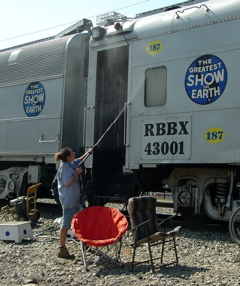
While some perform, others 'clean house.'
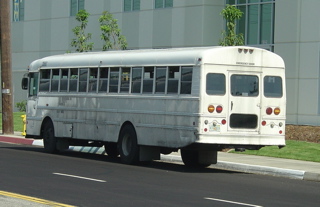
The Feld Ent. bus used to transport workers and performers from the
train coaches to the arena.
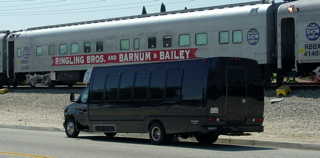
Additonal coach rented to transport personnel to and from the arena.
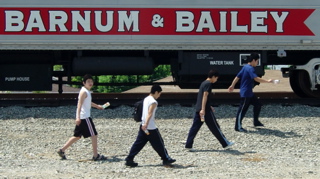
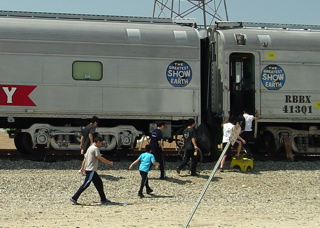
Performers returning to the train from the arena.
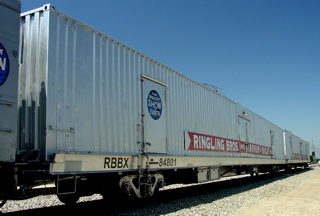
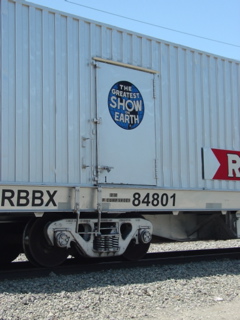
New concession cars (2) each with 2 intermodal containers and 3 side
doors per flat car.

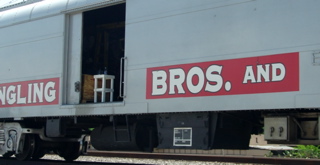
Shop Car


One of two generator cars.
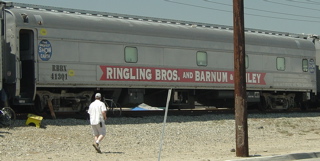
Trainmaster, Alex Kettles, goes back to work.
[
Back to the Circus Train Webpage by Carl
Morrison ]
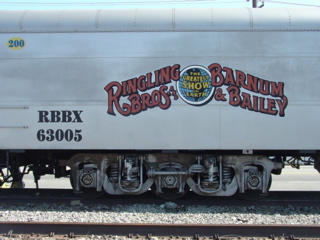
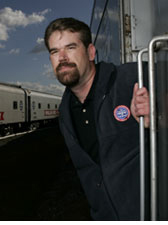 Trainmaster
Trainmaster